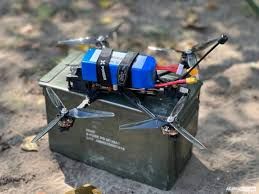
Former Google CEO Eric Schmidt is at the center of a new tech venture, White Stork, a startup developing kamikaze drones powered by artificial intelligence. The project, operating under shell companies, aims to provide Ukraine with advanced drone technology for its ongoing conflict with Russia.
In a groundbreaking venture that was under wraps until the beginning of this month, former Google CEO Eric Schmidt has created White Stork, a startup set to revolutionize warfare with its development of low-cost kamikaze drones.
Although Storks are normally considered a symbol of peace, there is very little that is peaceful about the objective of this not-yet-publicly announced startup.
The primary objective of this project, which is at the intersection of artificial intelligence and military technology, is to equip Ukraine with cutting-edge drone capabilities in its ongoing conflict with Russia and to develop an American alternative to Chinese drones.
Mass-producible drones
Officially established in August, the company focuses on creating mass-producible drones utilizing AI for visual targeting, specifically designed to operate in environments with disrupted communication caused by GPS jamming.
Despite remaining in stealth mode, the project has become an open secret within the drone community, drawing attention to Schmidt’s involvement and his extensive efforts to support Ukraine’s military capabilities.
Storks are also the national bird of Ukraine.
Departing from traditional arms manufacturing approaches, Schmidt envisions the affordability and military significance of these drones as a pivotal advantage against Russia.
Schmidt’s previous role as the head of the National Security Commission on Artificial Intelligence also provides a backdrop to White Stork’s emergence.



Affordable warfare?
The kamikaze drones developed by White Stork are estimated to be at a mere $400 each and come equipped with a small payload of explosives, Schmidt wrote in the Wall Street Journal in July.
Schmidt emphasized their cost-effectiveness and their relevance to the Ukrainian conflict. He pointed out the dwindling significance of conventional arms deals in favor of these AI-powered weapons.
However, Schmidt’s contention that Ukraine is currently losing the drone war and predicts a surge in the importation of millions of drones by 2024, is a clear direction to where the warfare is going. The AI arms race is on.
The opaque nature of White Stork’s operations, conducted through shell companies, adds an additional layer of intrigue and scrutiny surrounding the project.
Schmidt’s history of advocating for military technology
The startup’s operations have been concealed under various LLC names, including Swift Beat Holdings, which later changed its name to White Stork Group LLC, reported Forbes.
The umbrella corporation, Volya Robotics OÜ, with Schmidt as its sole beneficial owner, further adds to the project’s opaque nature.
The inclusion of Sebastian Thrun, a prominent figure in the tech world and co-founder of Google’s X research lab, among the veterans recruited for this project highlights the depth of expertise backing White Stork.
Schmidt’s history of advocating for military technology, his extensive government connections, and his strategic investments in defense tech further solidify his role as a key player bridging Silicon Valley and the Pentagon.
Their collective knowledge, combined with the AI-powered capabilities of these kamikaze drones, presents the potential to reshape not only the ongoing Ukrainian conflict but also the future landscape of warfare, reported Interesting Engineering.
The success or failure of White Stork’s ambitious endeavor will undoubtedly shape the discourse surrounding the ethical considerations and strategic implications of integrating advanced AI into the realm of modern warfare.




























+ There are no comments
Add yours